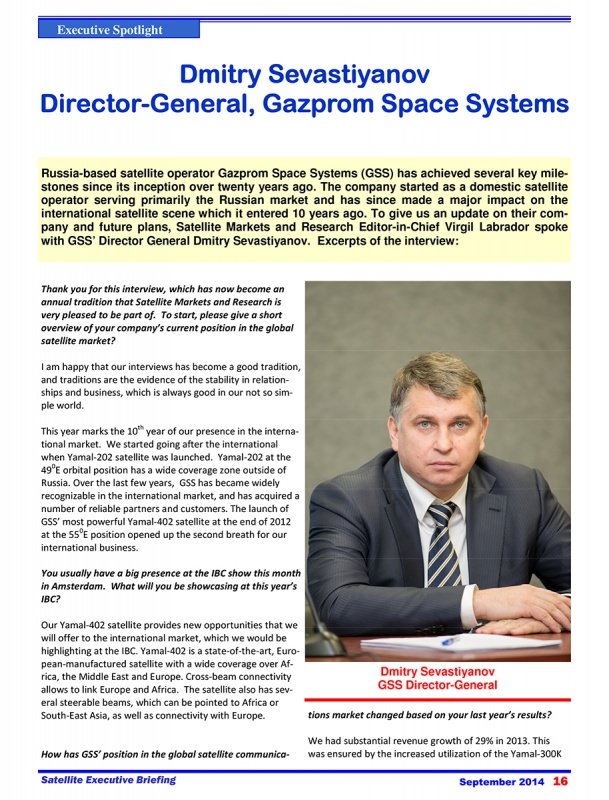Interview with Dmitry Sevastiyanov Director-General, Gazprom Space Systems
Russia-based satellite operator Gazprom Space Systems (GSS) has achieved several key milestones since its inception over twenty years ago. The company started as a domestic satellite operator serving primarily the Russian market and has since made a major impact on the international satellite scene which it entered 10 years ago. To give us an update on their company and future plans, Satellite Markets and Research Editor-in-Chief Virgil Labrador spoke with GSS’ Director General Dmitry Sevastiyanov. Excerpts of the interview:
Thank you for this interview, which has now become an annual tradition that Satellite Markets and Research is very pleased to be part of. To start, please give a short overview of your company’s current position in the global satellite market?
I am happy that our interviews has become a good tradition, and traditions are the evidence of the stability in relationships and business, which is always good in our not so simple world.
This year marks the 10th year of our presence in the international market. We started going after the international when Yamal-202 satellite was launched. Yamal-202 at the 490E orbital position has a wide coverage zone outside of Russia. Over the last few years, GSS has become widely recognizable in the international market, and has acquired a number of reliable partners and customers. The launch of GSS’ most powerful Yamal-402 satellite at the end of 2012 at the 550E position opened up the second breath for our international business.
You usually have a big presence at the IBC show this month in Amsterdam. What will you be showcasing at this year’s IBC?
Our Yamal-402 satellite provides new opportunities that we will offer to the international market, which we would be highlighting at the IBC. Yamal-402 is a state-of-the-art, European-manufactured satellite with a wide coverage over Africa, the Middle East and Europe. Cross-beam connectivity allows to link Europe and Africa. The satellite also has several steerable beams, which can be pointed to Africa or South-East Asia, as well as connectivity with Europe.
How has GSS’ position in the global satellite communications market changed based on your last year’s results?
We had substantial revenue growth of 29% in 2013. This was ensured by the increased utilization of the Yamal-300K and Yamal-402 satellites which were launched in 2012. This pushed our company revenues to surpass the key milestone of over US$ 100 million and advanced us three positions in the Top Fixed Satellite Service Operators annual ranking published by Space News.
Despite the tough competition in the international market, we successfully doubled our customer base outside Russia.
Now the international market comprise about 20% of GSS’ total revenues. Thousands of the end users in more than 70 countries receive essential services provided by GSS’ satellite capacity.
What markets are you focusing now? And which of these markets provide the most potential in the near future?
First of all, the Middle East and Africa are regions that continue to show a high growth potential. Operators of Free-to-Air and Pay TV channels, corporate (primarily oil and gas) sector, mobile operators, and government entities are driving demand for satellite services in these region. There is also high demand for Internet broadband access.
But these are markets where many global and regional operators are also present. Thus the competition is very high. We enter these regions offering not pure satellite capacity but cost-effective complex turnkey solutions. GSS does this business in partnership with the professional service providers and system integrators, which have extensive experience in these markets.
Can you cite some examples the successful partnerships you have made?
Providers which offer services to the large oil and gas companies in the Middle East, continue to increase the amount of capacity they are leasing from us in the European Beam of Yamal-402 satellite. Among these providers include well-known companies such as Globecomm Europe, ICCES (Saudi Arabia), Cobbett Hill (UK) and others. Recently CETel (Germany) became our new customer, it will use the European Beam capacity directly in Germany.
The traffic from Europe to Africa has been growing fast. The European teleports are using this capacity to provide Internet access for the remote regions of Africa. Among the most active customers include IABG (Germany), Global T&T (Belgium) and Castor (Netherlands).
The Southern Beam, which covers Africa to the South of Sahara, is in high demand as well. Telemedia (RSA) uplinks on Yamal-402 two packages of African TV channel from Johannesburg. Moreover, the capacity of this satellite is used for Satellite News Gathering (SNG).
Yamal satellites’ capacity is widely used for oil and gas projects in the Persian Gulf, near the Myanmar coast and in the Caspian Sea. GSS together with his partners participated in the implementation of a very complex project in the Arctic Ocean, for which the capacity of two GSS’ satellites are used: Yamal-202 and Yamal-402.
What can we expect from Gazprom Space Systems in the coming months?
The utilization of capacity of the Yamal-300K and Yamal-402 satellites continues to grow. So we expect revenues to increase further. The upcoming Yamal-401 satellite launch to the 900E orbital position will provide us with even more capacity. It will enable us to relocate the Yamal-300K satellite to the new more Eastern orbital position. Thus GSS will expand the geography of its international business by including the Russian Far East, the Northern part of China, Korea, Japan and the Northern part of the Pacific Ocean to its area of interest. The Steerable Beam of Yamal-300K satellite will also find its new place in South-East Asia. GSS has already started to pre-sell Yamal-300K satellite capacity at the new orbital position.
September 2014

